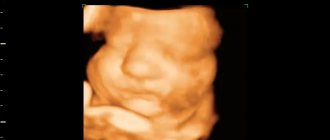Pain
Mild painful sensations that occur here and there are a common occurrence in the last months of pregnancy. Do not forget that the mother’s body experiences enormous stress during the period of bearing a child. Most often the pain is localized:
- in the lower abdomen and hypochondrium:
- in the calf muscles;
- in the head and neck;
- in the lower back.
If in the early stages pain in the lower abdomen appears due to the threat of miscarriage, then at week 29 they are caused by other reasons. These include rapid stretching of the muscular ligaments of the uterus, a shift in the pregnant woman’s center of gravity, pressure changes, and a lack of vitamins and microelements. The expectant mother should listen to her feelings and not delay going to the doctor if the discomfort worsens.
Discharge
Watery or bloody discharge is more dangerous. If they are detected, it is best to call a doctor at home, and if the condition allows, go to the clinic yourself. If the doctor confirms the threat of premature birth, the expectant mother will have to go to the hospital. Doctors always try to maintain the pregnancy, but if this is not possible, they perform a caesarean section.
Discharge from the genital tract is considered normal if it is not abundant, odorless and light in color.
If yellowish discharge appears, you should consult a gynecologist. It may be thrush, which can be treated with medication.
Enlarged uterus
The height of the uterine fundus is 29 cm (this figure is always equal to the number of weeks of pregnancy). The main female organ in which the embryo develops is already so large that sometimes it becomes difficult for a woman to take a breath. The uterus puts pressure on the diaphragm and causes shortness of breath. It seems that she has nowhere else to grow, but there are still three whole months ahead. During this time, it will become even larger, causing discomfort:
- frequent urge to urinate;
- indigestion, heartburn, constipation, hemorrhoids;
- weakness and dizziness, especially after resting in a supine position;
- swelling and varicose veins.
Severe swelling can trigger the onset of late toxicosis, when it is difficult to remove fluid from the body and the pregnant woman constantly feels sick. With this disease, the child receives insufficient oxygen, which can lead to developmental delays. Training contractions will become constant companions of pregnancy. Periodic uterine contractions can occur at any time of the day. It is necessary to carefully monitor the speed and intensity of muscle tension. If the sensations intensify, you should immediately go to a medical facility.
Fever and colds
It is difficult to protect yourself from colds during epidemics. Therefore, the expectant mother needs to arm herself with information on how to deal with the disease without harming herself and the baby. Here are some useful tips:
- Measure your body temperature. It must be remembered that in pregnant women it is slightly elevated - about 37 degrees. Therefore, when you see this figure on the thermometer, you should not panic - there is no fever.
- Take medications only as prescribed by your doctor. During pregnancy, almost all medications are prohibited. The general practitioner knows best which medications will not harm the child, so you need to buy medications with a prescription.
- Rest and sleep more, ventilate the room.
- Drink more warm liquids: tea, water, fruit drink, milk.
- Use traditional methods of treating colds. Herbal medicine will help cope with runny nose, cough and headache.
How does a pregnant woman feel at 29 weeks?
So, the 29th week of pregnancy has arrived.
There is only 1 week left until the cherished maternity leave. You will be able to pay more attention to yourself and your baby, attend a school for expectant mothers, and focus on the final period of pregnancy. If you're still working, try not to overwork yourself. Even when doing household chores, ask your family for help. Premature birth at this stage is not a universal phenomenon, but there is still a risk. Take care of yourself! During this period, the expectant mother should monitor her weight. Weight gain at 29 weeks of pregnancy should be about 10-12 kg. The norm for weight gain is approximately 300-350 g per week. If a pregnant woman recovers more rapidly, you need to make sure that this is not due to fluid retention in the body. Swelling during pregnancy at this stage occurs in most expectant mothers; a salt-free diet, correction of the drinking regime and special exercises for pregnant women will help solve the problem. But do not lose your vigilance: any manifestation of severe swelling of the face, fingers, lower back and abdominal wall may indicate the presence of a serious complication called “preeclampsia”. To diagnose and treat it, you must consult your doctor.
29,30,31,32 weeks of pregnancy: what happens, development of pregnancy and fetus
- home
- Services and prices
- Services and prices
- About Us
- Doctors
- Schedule and appointments
- Reviews
- Doctor training
- Clinic addresses
- Blog
- CIropedia
Week by week 29 - 32 weeks of pregnancy Elena Gevorkova Obstetrician-gynecologist, Moscow
Week 29
BABY
The length of the fetus is 36-37 cm, and the body weight is 1200-1300 g. By this time, the baby’s skin becomes smoother, as subcutaneous fat continues to accumulate, smoothing out all wrinkles and folds. The body of the fetus is covered with vellus hair, but its number is already less than in earlier stages. On the contrary, the hair on the head thickens, grows and darkens. The baby blinks frequently, opening his eyes wide.
By this time, fetal movements become less active, frequent and intense tremors are replaced by smoother movements: the baby straightens his arms and legs, protrudes his head and pelvic end.
There is little free space in the uterus, and the fetus, which has reached quite large sizes by this time, is forced to remain in one position most of the time. Since its head is heavier than the buttocks, the fetus takes a head-down position in the watery space of the uterus - this is the so-called cephalic presentation. At this stage, there are frequent situations of breech presentation, when the legs and buttocks of the fetus are located at the bottom of the uterus. Most often, in the following weeks, the child turns over, taking a physiological cephalic presentation. In some cases, this does not happen, and the baby “sits on his butt” until full term. Breech presentation will play an important role when choosing a delivery option. EXPECTANT MOTHER
The intensive growth of the uterus continues, and the internal organs located in the vicinity of the uterus continue to experience discomfort. In the most cramped conditions are the “neighbors” of the uterus - the stomach, bladder and lower part of the large intestine: these are organs with a cavity inside. They are displaced by the growing uterus and take a forced position, which can affect their work.
“Suffering” of the stomach can be manifested by heartburn, a feeling of heaviness after eating. Heartburn is discomfort that occurs when stomach contents reflux into the esophagus. This condition is manifested by a burning sensation and an unpleasant taste in the mouth. During pregnancy, the muscle that separates the esophagus from the stomach, under the influence of hormones, in particular progesterone, relaxes, which makes it possible for the acidic contents of the stomach to flow “from the bottom up” into the esophagus. Changing the position of the stomach aggravates this situation. That is why the expectant mother should eat small portions, chewing her food thoroughly - this will significantly alleviate her condition. Increasing pressure on the bladder causes frequent urination, which can accompany the pregnant woman until childbirth. False urges are also possible, when the brain sends a signal about the need to urinate, but the bladder is not yet full and there is no urine output at all or in very small quantities. During pregnancy, the situation of frequent and painless urination is not a sign of any disease. When other symptoms occur: cloudy urine, pain, etc. - You should inform your doctor about this to rule out pyelonephritis and other diseases.
30th week
BABY
The baby's height this week is 37-38 cm, and body weight is about 1300-1400 g. At the 30th week, an intensive increase in muscle mass occurs, and frequent movements of the fetus are designed to train the muscles of the limbs, since by the time of birth the baby should have strong muscles of the arms, legs, chest, back. The expulsion of the fetus (the so-called second stage of labor - the direct birth of the child) is carried out due to contraction of the uterus, the muscles of the abdominal wall and the independent movements of the baby. The high tone of the muscles of the fetal body makes it easier to make forward movements, facilitating movement along the birth canal.
Also during this period, preparation for extrauterine life of internal organs continues. The chest makes movements similar to breathing - it expands and contracts. The lungs are washed with amniotic fluid, and the production of surfactant, a special substance that ensures pulmonary respiration, continues. Alveoli, the vesicles of lung tissue in which gas exchange occurs, develop intensively. Readiness for independent breathing is the most important indicator of fetal survival. If for some reason childbirth occurs at this stage, then the maturity of the lung tissue is already capable of ensuring the breathing of the newborn.
The fetus constantly swallows amniotic fluid, which causes the organs of the gastrointestinal tract to contract and stimulates the functioning of the liver and pancreas. The liver performs the most important function of purifying the blood and at this stage is ready to function in full, since the formation of this organ, or more precisely, the liver lobules as a structural unit, is almost complete by this time. The pancreas produces enzymes and hormones, the most important of which is insulin, in small quantities, since during pregnancy the fetus only needs to process amniotic fluid, which requires a small amount of enzymes. But potentially the pancreas at this stage is already ready to fully supply the newborn’s body.
The constant supply of amniotic fluid forces the kidneys to function intensively and produce urine from the liquid part of the amniotic fluid.
The amount of urine during this period can reach up to 500 ml per day. Thus, during this period, the internal organs are able to ensure the vital functions of the newborn in the event of childbirth, but the process of their maturation and improvement will continue until full term. EXPECTANT MOTHER
Pregnant women may notice swelling of the breasts and the release of colostrum from the nipples: this is the name for the secretion of the mammary glands, “primary milk”. Colostrum appears as a thick, whitish or yellowish liquid. Its release can begin at different stages of pregnancy, but most often it occurs after the 30th week. The appearance of colostrum indicates that a woman is actively preparing for lactation—feeding her baby with breast milk. In the first days after birth, colostrum is released more intensely and precedes the appearance of breast milk.
During pregnancy, colostrum production is stimulated directly by the fetus. His adrenal glands synthesize a special hormone that interacts with the hormones of the placenta and activates the production of prolactin, a hormone from the mother’s pituitary gland responsible for milk production. It is he who will be responsible for breastfeeding after childbirth.
At 30 weeks pregnant women are issued a certificate of temporary incapacity for work - maternity leave is issued. Its duration is 140 days - 70 days before and 70 days after childbirth.
31st week
BABY
The body length of the fetus is 39-40 cm, and the weight is 1500-1600 g. During this period, important stages of the formation of the fetal nervous system continue.
The brain grows rapidly, the convolutions deepen, increasing the surface area of the cerebral cortex. The brain and all its parts function as a single system; such interaction is ensured by many nerve connections. By this time, the periods of sleep and wakefulness alternate quite clearly, and sleep still takes a longer time than the period of activity. During sleep, the fetus's eyes are closed, and during wakefulness the baby opens them. The eyelids are already very well developed, which makes a variety of movements possible: the fetus can open its eyes wide, squint, squint, and blink frequently. As a rule, the fetus's eyes are always open, and he closes his eyes when bright light hits the mother's stomach or when the surface of the eye is touched: this is another evidence of the high development of the nervous system - the corneal reflex. EXPECTANT MOTHER
The increase in body weight by this period is approximately 7-8 kg. It is necessary to monitor the intensity of weight gain, since too rapid weight gain may indicate poor kidney function. The weekly increase should not exceed 300-400 g per week. You should be very careful about the appearance of swelling in your arms and legs and report it to your doctor. Fluid retention in a pregnant woman's body can become the first stage of complications in the second half of pregnancy - gestosis, which is also called late toxicosis. In addition to edema, signs of mild to moderate gestosis also include increased blood pressure and the appearance of protein in the urine.
The initial stages of gestosis can occur without pronounced changes, and the pregnant woman can feel great without complaining. This is why regular visits to the doctor and timely testing are so important. Preeclampsia is the most common cause of complications for both the fetus and the mother. As a result, the baby may experience developmental delay, hypoxia, etc., and the woman may experience impaired renal, liver, cardiovascular system function and other dangerous conditions.
A mild degree of gestosis, dropsy in pregnancy, is characterized by the appearance of edema and can be corrected by normalizing water-salt metabolism: for this, the expectant mother can be prescribed a diet, herbal preparations, etc.
Moderate and severe degrees of gestosis - nephropathy, preeclampsia and eclampsia - require intensive care in a hospital setting. Nephropathy in pregnant women is characterized by the fact that the edema present at the stage of dropsy is accompanied by episodes of increased pressure and the appearance of protein in a general urine test.
With further progression of gestosis, a severe degree of nephropathy turns into preeclampsia - a condition for which, in addition to severe edema, high blood pressure and protein in the urine, is characterized by signs of cerebrovascular accident: dizziness, headaches, as well as neurological symptoms - changes in reflexes, nausea and vomiting .
The most severe stage of gestosis, eclampsia, is characterized by the presence of convulsive seizures followed by the development of coma.
It is extremely important to detect signs of gestosis at an early stage and be sure to treat this condition, since the increase in complications can occur quickly and lead to serious and sometimes irreversible consequences.
Week 32
BABY
The fetus at this stage weighs 1700-1800 g, and its body length reaches 41-42 cm. The baby's facial features are close to the appearance of a newborn child, the face becomes rounded, wrinkles are smoothed out, and the hair on the head is noticeably pronounced. The skin of the fetus is no longer bright red, but pink due to the even distribution of subcutaneous fat. The accumulation of such fat is essential for the process of thermogenesis - maintaining body temperature at a constant level. In adults, these processes are controlled by the brain - thermoregulation centers. By the time the baby is born, these centers are not yet able to fully provide thermoregulation, and that is why the presence of subcutaneous fat is extremely important for maintaining the correct body temperature of the fetus.
The period of 32 weeks is marked by important stages in the functioning of the immune system.
In the fetal blood there is a sharp increase in the level of its own immunoglobulins - special proteins that protect the baby from infections. By the time of birth, the level of immunoglobulins will increase, but this will happen due to the penetration of mother’s immunoglobulins into the fetus’s body. In the last weeks of pregnancy, the permeability of the placental barrier increases, which allows the protective cells of the mother's body to pass into the baby's blood. EXPECTANT MOTHER
Pain in the back, in the pubic area and large joints, such as the hip, knee, a feeling of fullness and pain in the pelvic bones - these phenomena are present to one degree or another in many pregnant women in the third trimester. A change in the center of gravity of a woman’s body due to an increase in the volume of the abdomen leads to some displacement of the spine, which entails the above-mentioned problems. On top of that, the mother’s body begins preparing for childbirth by producing the placental hormone, relaxin. It causes the ligaments to relax, and during childbirth the pelvis becomes more pliable, which ensures the free passage of the baby through the birth canal. During pregnancy, high levels of the hormone relaxin “loose” the ligaments, which results in painful sensations.
Regular physical activity - fitness, yoga, swimming, walking - will help reduce the manifestations of such ailments. The stronger the back muscles, the better they will support the spine and the less pregnant women will feel pain and discomfort in the lumbar region.
At this time, it is recommended to wear a bandage and choose the correct position while sleeping: it is advisable to sleep on your side so that there is no load on the spine and the back muscles are in a relaxed state. It is possible to use special back bolsters or pillows for pregnant women: these devices will help the expectant mother find a comfortable position that allows her to relax the muscles of her back and legs, and cope with a frequent companion of the third trimester - back pain.
Belly size at 29 weeks
The abdominal circumference at the 29th week of pregnancy is approximately 81-86 cm.
At the 29th week of pregnancy, discharge is also an object of control. Normally, there is a homogeneous, transparent (or milky) discharge without a strong odor. If bloody discharge is detected, you should immediately consult a doctor, as this may be a sign of premature birth, previa, or placental abruption.
A feeling of heat is another unpleasant phenomenon that expectant mothers often complain about at 29 weeks of pregnancy. This occurs due to the acceleration of metabolism, which causes increased sweating processes and increases the load on the heart. Some pregnant women experience decreased blood pressure and increased heart rate.
Weight gain at 29 weeks of pregnancy ranges from 5.6 kg (with a BMI of more than 26) to 10 kg (with a BMI of less than 19.8). To calculate your individual weight gain at 29 weeks, use the pregnancy weight gain calculator.
Weight gain
Russian gynecologists are confident that during pregnancy a woman should gain no more than 12 kg, while their Australian colleagues, for example, believe that the maximum gain is 18. This once again proves that the weight gained while expecting a baby may have deviations from the norm. The “adequacy” of these deviations is determined by the doctor. Nevertheless, there are approximate figures. The total weight gain by the end of the 29th week, according to domestic experts, for women of normal build is about 9 kg.
Baby's measurements at 29 weeks
At 29 weeks, the baby is about the size of a papaya.
At week 29, your Baby has already acquired quite noticeable dimensions - his height is 35-36 cm, and his weight is 1100-1200 g. By this time he:
- reacts to noises: his pulse quickens, he flinches or blinks. This reaction currently occurs in response to very loud sounds, but every day your Baby’s hearing will become finer;
- The baby can distinguish musical sounds quite well, so it makes sense to introduce him to good music if you have not already done so;
- Eyelashes appear on the Baby's eyes;
- the heartbeat can be easily heard with a stethoscope;
- you can feel what the Baby is going through: whether he is happy or upset, calm or excited, hungry or well-fed.
Three-dimensional ultrasound at 29 weeks
What happens to the stomach
The belly continues to increase in size as the baby grows and develops. The skin on the abdomen becomes increasingly tight, which can lead to feelings of dryness and itching. To reduce discomfort, you need to moisturize it regularly. To do this, you can use regular cream, or a special gel or milk. Various oils help to cope with dry skin.
Sometimes itching in the abdominal area is caused by completely different reasons that are not related to pregnancy. For example, the skin may itch due to exposure to an allergen (washing powder, food, cosmetics, etc.). In this case, you should try to independently determine the cause of the allergic reaction and try to get rid of the irritant. If this is not possible, you must contact specialists.
Sometimes women watch with surprise the rhythmic twitching of the abdomen. Do not be alarmed, they occur due to the fact that the child hiccups. As a rule, hiccups do not last long.
From time to time, a woman may feel mild pain in the abdominal area, similar to contractions. In this way, the uterus is prepared for the upcoming birth, and the contractions themselves are training. All you have to do is lie down on your side and rest, after which everything will pass.
Helpful advice: learn to express your love for your future baby
Scientists believe that a mother’s love for her baby does not arise immediately after tests confirm his existence.
Some experts claim that feelings arise from the moment the mother first feels movements, others say that from imprinting, that is, at the moment of the first meeting of the mother with the child after his birth. Do you feel something for your Baby? Mind or soul? Let's try to understand this. Express your attitude to the following phrases (yes/no) as it is today:
- when you think about the Baby, you feel a pleasant warmth or tingling in your chest, a mysterious smile appears on your face;
- You consider your actions from the point of view of what is useful/harmful for the Kid and only secondarily - whether I want/don’t want to;
- it gives you pleasure to think about the near future, when the Baby is born, you will be able to hold him in your arms, kiss him, cuddle him, breastfeed, bathe, care for him;
- you come up with a name for the Baby, try it out on your tongue, select diminutive options, imagine how you will call out to the Baby when he grows up a little. And of course, combine first names with patronymics, listen to how it sounds - beautiful, easy, funny, respectable or ridiculous;
- you want to quickly find out the gender of the child, although what matters is not “boy or girl”, but the desire to think of the Baby as a son or daughter, look for things, furniture, toys oriented towards the child’s gender, communicate with him as a boy or girl;
- you are looking forward to your baby “getting in touch”, that is, making himself known with pushes and movements. At such moments, you like to feel “together”, to feel your significance and importance because you are a mother. You can even scold the Kid if he has been quiet for a long time or if he has become very naughty and does not want to calm down;
- you get a little worried when the test results come back or when your doctor takes measurements and listens to the Baby’s heart. And your first question is: is everything okay with the Baby?
- you actively communicate with other mothers expecting babies, support them and receive support yourself;
- you read books and articles on the Internet related to the development of children before and after birth;
- the main topic in your communication with your husband, friends and female colleagues is your child (or children in general);
- you always come across expectant mothers and parents with Babies, both in real life and in TV shows, advertising, online, magazines, etc.;
- you think that in transport and in queues it would be nice to take your position into account;
- you jealously protect your Baby (your belly) from prying eyes, you do not like the obsessive attention of others to you;
- you know the conditional date of birth of the Baby and are counting the days until the moment when you can hold him in your arms for the first time.
Of course, love for the baby is not limited to these phrases. But if the listed guidelines have not yet become part of your life, your love for the Baby is still in the formative stage. Very little time will pass, and after reading most of the phrases, you will say: so it is.
Lifestyle
In the third trimester, try not to lift heavy objects - otherwise you risk triggering early labor. But what to do if the purchase, despite everything, took place, and no one can help you bring the packages from the store? Firstly, never buy too much (no more than 2-3 kg), secondly, distribute your purchases evenly among bags (don’t carry everything in one hand or on your stomach) and thirdly, don’t forget to put it on before going out go outside with a prenatal bandage - it will help to properly distribute the load on the spine.
Good to know
Edema during pregnancy
What is gestosis
Dangerous changes: gestosis in pregnant women
Swelling, protein in urine, high blood pressure: gestosis in pregnant women
Pregnancy: dangerous signs. When to go to the doctor?
Intrauterine growth restriction
All texts for pages about mother and baby were kindly provided by RAMA Publishing - these are chapters from the book by Svetlana Klaas “Your Favorite Little Man from Conception to Birth”, reviewer Irina Nikolaevna Kononova, Candidate of Medical Sciences, Associate Professor of the Department of Obstetrics and Gynecology of the Ural State Medical Academy (Ekaterinburg).
Intimate life
Sex and 29 weeks of pregnancy are completely compatible concepts, provided that there are no contraindications. However, it is still necessary to observe a number of precautions. For example, you need to avoid putting pressure on the abdomen, avoid uncomfortable positions, do not make too sudden movements, and avoid deep penetration. The optimal position is when the man is behind the woman.
Otherwise, there are no obstacles to intimacy. Moreover, thanks to sex, a woman’s mood improves and emotional stress goes away. If any doubts remain, you should consult a doctor about this.
Nutrition
The course of her pregnancy and the health of the child depend on how well a woman’s diet is structured. Every day, the baby’s body requires a lot of calcium (about 250 mg). Moreover, the fetus will definitely “take” it, if not from the incoming food, then from the internal reserves of the woman herself. Therefore, they must be replenished. The calcium that is best absorbed is the one that enters the body not in the form of artificial supplements, but with food, and with food of plant origin. Otherwise, this may lead to premature ossification of the skull, which will cause certain problems during childbirth.
It is imperative that a woman’s body receives enough protein, since the child needs it to gain its own muscle mass. If for some reason the expectant mother denies herself meat dishes, then she should receive calcium from plant foods.
A properly structured diet will help you avoid digestive problems, and sufficient fiber intake will make it possible to prevent the development of constipation and hemorrhoids. The maximum amount of fiber is found in vegetables and fruits, so they should be present on the table every day.
Do not overload your stomach by eating too large portions. It is best to completely remove fried foods from your menu. The same goes for salt – it needs to be limited. In this way, the risk of edema will be minimized.
It is interesting that previously women were completely recommended to adhere to a lenten menu, starting from the third trimester of pregnancy. At this point in time, this is not practiced, however, the total calorie content of servings should be reduced by limiting flour dishes, smoked foods, and confectionery products.
Do not forget about sufficient intake of iron into the body. Beetroot, spinach, oatmeal, buckwheat, tongue, and liver can replenish its reserves. Contrary to popular belief, chocolate does not help with anemia, but it can add extra pounds.
Fetal development
Week 29 - how many months is it? This is 6 calendar months and 20 days of pregnancy, or 7 obstetric months and 1 week. The moment of childbirth is getting closer.
The child’s height is 36–37 cm, the approximate weight at 29 weeks of pregnancy is 1200 grams. The fetus has already grown quite a lot and it is becoming increasingly difficult for it to fit into the uterine cavity. The child’s movements are no longer so sweeping and chaotic.
The skin begins to lose its vellus cover. First, the shoulders and lower back become bald, then other parts of the body. In the same sequence, a little later the original lubricant will disappear - the secretion of the sebaceous glands that accumulates on the surface of the skin.
The arms and legs are still thin, but subcutaneous fat accumulates and forms characteristic folds in the joint area.
The visual analyzer is being improved. The baby blinks rhythmically, tries to focus his gaze, and distinguishes primary colors.
The baby's nostrils are gradually cleared of mucus accumulation, allowing amniotic fluid to enter the nasal passages. This helps develop the sense of smell. The child can distinguish a pleasant aroma from foul odors.
The baby's blood contains all the formed elements. Red blood cells already carry oxygen, white blood cells are ready to protect the body from infections, and platelets are ready to stop bleeding. Heart rate is 140–150 beats/min.
The digestive system is completely ready to work independently. The pancreas produces all the enzymes necessary for the complete digestion and absorption of milk. Enamel is deposited on the rudiments of baby teeth.
The kidneys produce up to 500 ml of urine per day. The structure of the genital organs is improved.
The development of the baby at the 29th week of pregnancy is not as intensive as before.
How is ultrasound performed at different stages of pregnancy?
The content of the article
In the first trimester, ultrasound is performed in two ways - transvaginally or transabdominally. After the 12th week of pregnancy, ultrasound diagnostics are performed only through the anterior abdominal wall.
The method is based on the ability of ultrasonic waves to be reflected differently from body tissues with different densities. As a result, an image of the fetus appears on the device screen in real time. The doctor can assess the size, location and characteristics of the child’s intrauterine development.
A pregnant woman does not require special preparation before an ultrasound. If an examination through the anterior abdominal wall is scheduled before week 12, you should drink 0.5-1 liter of clean water before the procedure. This improves visualization of the fetus. In later stages of pregnancy, this function is performed by amniotic fluid.
Advantages of ultrasound during pregnancy:
- high information content of the method;
- safety for mother and fetus;
- painlessness of the procedure;
- the possibility of repeating the study multiple times at different periods;
- early identification of indications for abortion and induced childbirth;
- detection of conditions that can be corrected in utero.
Additional examination
In addition to traditional weighing, measuring blood pressure, assessing the height of the uterine fundus and abdominal girth at 29–30 weeks, it is recommended to undergo a third ultrasound, as well as testing for carriage of particularly dangerous infections - HIV, viral hepatitis B and C, syphilis.
During the ultrasound examination, the doctor will measure the main dimensions of the baby, which will allow him to approximately estimate his weight during childbirth, see his position in the uterine cavity and roughly decide whether the woman will give birth on her own or will have to have a cesarean section. In addition, with the help of ultrasound, you can see congenital defects and prepare for the birth of a special baby.







